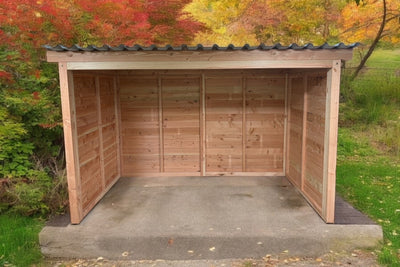Using rainwater in the garden: Advantages for Swiss families
For many Swiss families, their own garden is a place to take a deep breath - a natural play area for children and a relaxing retreat from everyday life. However, especially in hot summer weeks, for example on the Central Plateau or in Ticino, watering can become a challenge. Rising temperatures and longer periods of drought put a strain on plants and increase drinking water consumption. Well thought-out rainwater harvesting in the garden saves resources, reduces costs and makes you less dependent on tap water.
Clever use of rainwater in the Swiss garden: Advantages for families

Although Switzerland is considered to be a water-rich country, summers are becoming increasingly dry in some regions. Anyone who has to water their lawn or raised bed in a hot July quickly realizes that tap water costs money - both ecologically and financially. Rainwater offers an efficient, environmentally friendly solution that is particularly useful for garden maintenance.
The collected water is low in limescale and therefore well tolerated by your plants. Tomatoes, raspberries and roses have been shown to thrive better with natural irrigation. Families benefit twice over - because children can splash around in the garden with a clear conscience. At the same time, access can be reliably designed with childproof systems.
Advantages of rainwater harvesting in the garden at a glance:
- Ecological: saves drinking water, reduces runoff into sewers
- Economical: noticeably reduces water charges
- Plant-friendly: ideal for lime-sensitive vegetation
- Child-friendly: safe and sensible ease of use
With the right solution, you can provide targeted irrigation - from raised beds to hedges. Or create a play area with long-term water fun. More on this in the next sections.
Using rainwater in the garden: legal requirements in Switzerland
In Switzerland, the private use of rainwater is generally permitted. However, please note the cantonal regulations: In many municipalities, a permit is required for storage volumes of 4000 liters or more. Especially for underground cisterns or systems with a direct house connection, a building notification or permit is required.
Important: Mixing with the drinking water network is strictly prohibited. The Drinking Water Ordinance requires clear separation. If you want to run a toilet or washing machine with rainwater, for example, you need certified backflow preventers and installations that meet current standards.
Find out in advance from your local authority. Cities such as Zurich or Bern offer free information sheets on their websites under the keyword "Rainwater use in the garden".
Child safety with rainwater systems
Collected water harbors dangers - especially for small children. Even a 300-liter tank that has been left empty can be critical. The following therefore applies:
- Only use tanks with childproof lids in accordance with the DIN standard
- Securely cover or avoid open rain barrels
- Remove climbing aids or raised areas around tanks
- Secure underground cisterns with a lockable manhole cover
Additional protection: there are safety valves and lockable taps for drawing off water. This keeps gardening safe for children too.
Rainwater tanks and cisterns: the right system for your garden in Switzerland
Which rainwater system is best for you depends on the space available, your requirements and the level of convenience you want. Above-ground systems are suitable for smaller gardens or beginners - also ideal for combining with a garden hose or drip irrigation. If you want more capacity, you can supply entire properties with underground cisterns.
Comparison: above-ground tanks vs. underground cisterns
Above-ground tanks - usually in the form of rain barrels - offer between 200 and 1000 liters of capacity. Modular expandable models can hold up to 5000 liters. These systems are easy to install and do not require a building permit in Switzerland (below defined volume limits).
- Easy to install without earthworks
- Low costs (from approx. CHF 100)
- Ideal for manual watering and beginner projects
Underground cisterns can hold up to 10,000 liters. They are suitable for automatic garden irrigation, toilet flushing or washing machines. However, the price including installation is usually CHF 3000 or more. Depending on the region, registration or a planning application may be required.
Flexible use of rainwater - even in the home
Rainwater can be used beyond the garden - with filtration and UV disinfection also for:
- Toilet flushing
- washing machines
- Pond or water features
Important: The domestic water connection must not be connected to rainwater pipes. A specialist plumbing company can help with standard-compliant implementation.
Space-saving rainwater harvesting planning - for every garden
Clever planning determines how effectively rainwater can be used. Smaller gardens benefit particularly from space-saving systems such as wall-mounted tanks or shallow rainwater barrels along the house wall.
Choice of location for cisterns and rainwater tanks
Above-ground tanks should be located as close as possible to roof falls - this reduces the amount of material required. Choose a shady position so that the water does not heat up or form algae. An overflow must also be drained correctly (e.g. towards a soakaway).
Underground systems require a location with good access, distance from trees (root pressure) and no underground pipes nearby.
Integration into existing garden design
If you don't want to disturb visible tanks, you can integrate them into structures:
- Disguise them as the back of raised beds
- Conceal them behind wood paneling or plants
- Hide under playhouse or garden platform
If space is limited, a wall tank (300 to 500 liters) on outbuildings or patio walls is a good idea - also ideal for townhouses.
If you opt for automatic irrigation, you should plan in advance for a pump with a capacity of approx. 500-700 watts and suitable pipes.
Installation: How to practically implement rainwater harvesting in the garden
Step-by-step instructions for your garden
- Calculate requirements: 1 m² of roof yields around 0.6 liters per mm of precipitation
- Plan the system: define the space, volume, type of extraction and filtration
- Buy suitable components from CH dealers such as Gutta, Hornbach Schweiz or Kilcher Gartenbau
- Install above-ground systems yourself - call in a professional for excavation work
- Set up downpipe connection, with filter and overflow
- Check system for leaks and put into operation
Material selection and handling in everyday life
Look for UV-stable polyethylene for durable tanks. Filters should be easily accessible and replaceable. A tap with a Gardena-compatible thread is recommended for water withdrawal - also for an automatic watering system.
Childproof closures and regular practice with the whole family are recommended.
Maintenance and care of your rainwater system in Switzerland
Maintain rainwater systems correctly, avoid damage
Regular maintenance prevents algae growth, odor and blockages. Avoid the following:
- Filters that are not cleaned - leaves and dust quickly collect there
- Stagnant water in winter - frost can damage tanks
- Leaks due to old seals or material damage
Ideal maintenance schedule: Visual inspection in spring, emptying and flushing in fall before the onset of winter. Replace filter annually, check seals.
Maintenance costs and tips for promotion
The running costs are manageable: around CHF 20-50 per year for spare parts and maintenance. For larger systems, a pump service or seal change is also required. Long-term maintenance saves repair costs.
Tip: Ask your local authority about subsidy programs. Cities such as Lucerne or Zurich support rainwater storage tanks with financial subsidies or advice. You can find further information on bafu.admin.ch.
Conclusion: Sustainable rainwater harvesting in the garden brings real added value
Whether you are tending a vegetable patch, looking after your lawn or enjoying the summer with your children: With well thought-out rainwater harvesting in the garden, you save money, reduce the impact on the environment and increase the comfort of using your outdoor space.
Switzerland is already feeling the effects of climate change - dry summers and hot spells are becoming more frequent. This makes it all the more important to use water in a sustainable and regionally compatible way. From small wall-mounted tanks to fully integrated cisterns, many things are possible.
Start by taking a look at the roof, check the space in the garden and start with a suitable entry system. This is how you garden sustainably - today and in the future.


